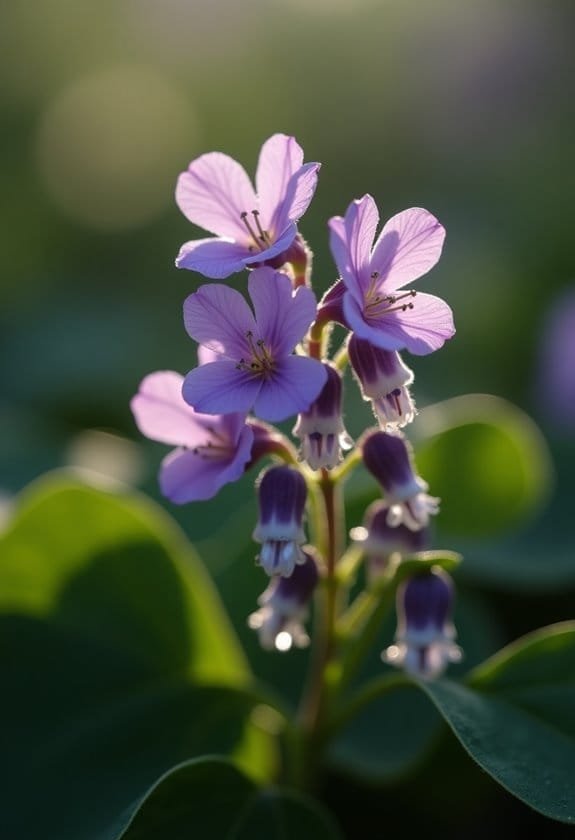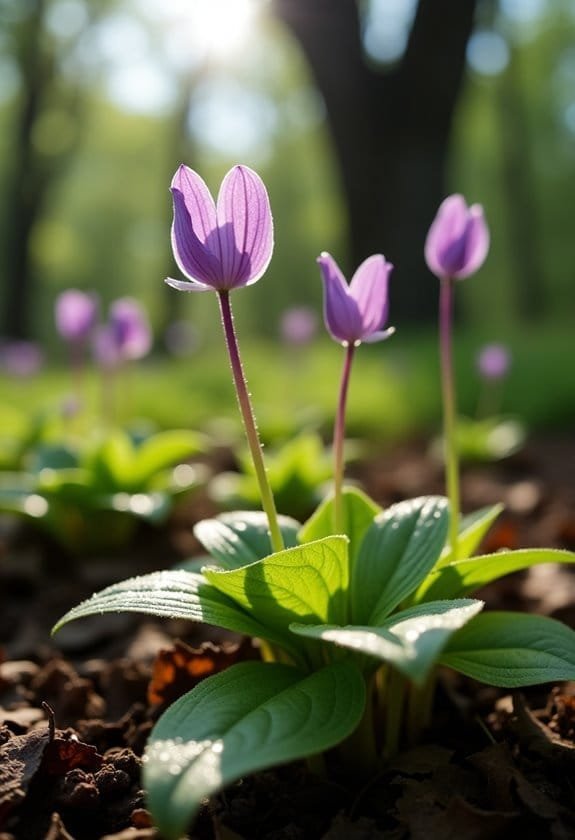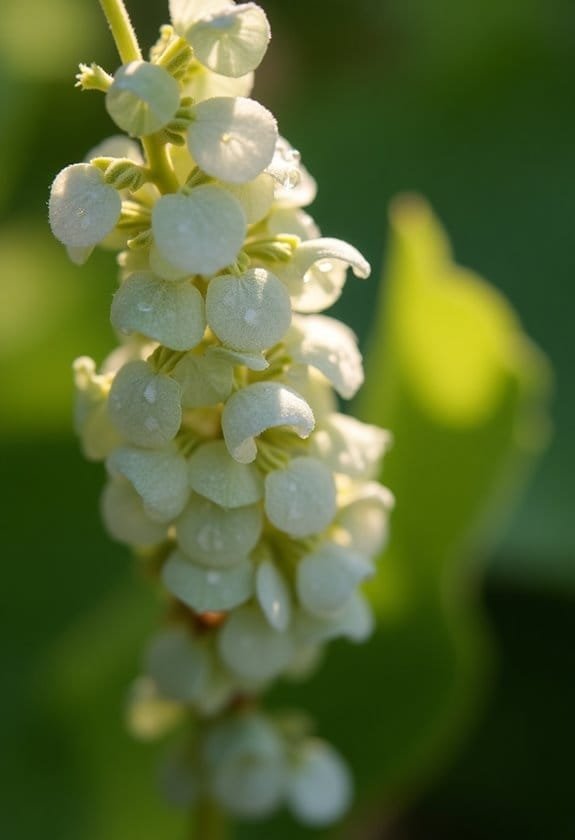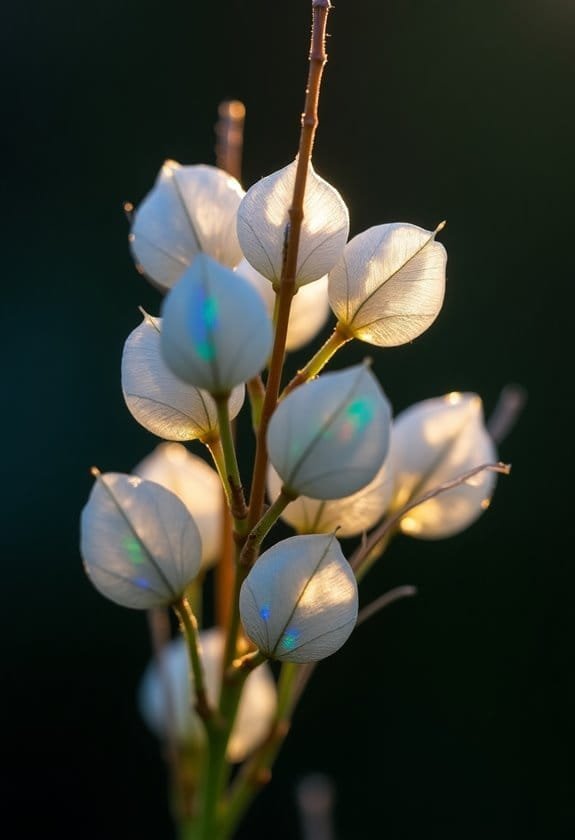Lunaria annua, commonly called Honesty or Money Plant, is a striking biennial in the Brassicaceae family that reaches heights of 2-3 feet. It's prized for its vibrant purple or white spring blooms and distinctive translucent seed pods that resemble silvery coins. The plant thrives in USDA zones 4-9, preferring well-drained soil and partial to full sun conditions. Its moon-shaped pods, which give rise to the genus name "Lunaria," have earned it recognition from the Royal Horticultural Society for outstanding garden merit. Beyond its ornamental appeal, this resilient plant attracts essential pollinators and carries rich cultural symbolism that spans centuries of garden history.
Main Points
- Lunaria annua is a biennial flowering plant in the Brassicaceae family, known for its distinctive translucent, silver dollar-shaped seed pods.
- The plant grows 2-3 feet tall, producing purple or white four-petaled flowers in spring and early summer.
- Also called Money Plant or Silver Dollar Plant, it symbolizes honesty and prosperity in various cultural traditions.
- Thrives in full sun to partial shade with well-drained soil, and is hardy in USDA zones 4-9.
- Seeds appear in the second year after planting, and dried seed pods are popular in decorative floral arrangements.
Introduction

Lunaria annua, commonly known as Honesty or Money Plant, stands as a remarkable biennial specimen in the garden with its distinctive coin-shaped seed pods.
The plant's scientific classification places it within the Brassicaceae family, where it shares characteristics with familiar vegetables like cabbage and radishes.
Growing to an impressive height of 2-3 feet, this adaptable plant combines ornamental appeal with cultural significance, featuring translucent seed pods that have earned it various nicknames across different regions and traditions.
Common Name
This versatile plant's familiar names paint a vivid picture of its most distinctive feature – the translucent seed pods that shimmer like coins in the garden. Among its most widely recognized common names, Lunaria annua goes by Honesty, Silver Dollar, Money Plant, and Moonwort, each reflecting the plant's unique characteristics and cultural significance.
The name "Honesty" carries particular weight in the plant's historical narrative, symbolizing both sincerity and prosperity through its coin-like seed pods that catch and reflect light. These silvery, disc-shaped pods have inspired a fascinating connection to currency across cultures, most significantly in Christian tradition through the biblical account of Judas's thirty pieces of silver.
The Latin name "Lunaria" further enriches this botanical nomenclature, drawing from lunar imagery to describe the moon-shaped pods that have captivated gardeners for generations. In both ornamental gardens and floral arrangements, these distinctive features have secured the plant's position as a beloved specimen, with its common names serving as evidence to its enduring appeal across different cultural contexts.
Scientific Name
Precision in botanical nomenclature leads us to *Lunaria annua*, the scientific designation for the plant commonly known as Honesty. This taxonomic classification places the plant firmly within the mustard family, Brassicaceae, reflecting its genetic relationships with other cruciferous plants.
The genus name "Lunaria" derives from the Latin word meaning "moon-shaped," an apt description that captures the plant's most distinctive feature: its translucent, disc-like seed pods that resemble miniature moons.
The species epithet "annua" refers to the plant's biennial growth cycle, though this might seem contradictory since the plant actually takes two years to complete its life cycle.
This scientific name encapsulates both the plant's physical characteristics and its growth patterns, providing botanists and gardeners with essential information about its nature.
As a member of the Brassicaceae family, *Lunaria annua* shares characteristics with its relatives, including the four-petaled flowers typical of mustard family members and the distinctive silique fruit formation that develops into those characteristic moon-shaped seed pods.
Overview
Among Europe's most enchanting garden plants, Lunaria annua captivates observers with its distinctive coin-shaped seed pods and vibrant purple or white blooms. This biennial treasure, standing proudly at 2-3 feet tall, has earned its place in gardens worldwide through its remarkable versatility and ornamental value.
In garden settings, Lunaria annua demonstrates exceptional adaptability, flourishing in conditions ranging from full sun to partial shade. The plant's fragrant spring blossoms serve as a crucial nectar source for pollinators, while its translucent seed pods transform into silvery medallions that gleam in autumn gardens.
These papery pods, resembling ethereal coins suspended in mid-air, have earned the plant its common names of Honesty and Silver Dollar.
While its self-seeding nature guarantees continuous garden presence, careful monitoring may be necessary as it can become vigorous in certain regions. The Royal Horticultural Society has recognized Lunaria annua's outstanding garden merit, cementing its status as a valuable ornamental specimen that excels in both fresh arrangements and dried displays.
Key Features
Lunaria annua stands as a stately biennial, reaching impressive heights of 2-3 feet with its robust stems and medium green, serrated foliage.
The plant's most striking features include its four-petaled blooms, which emerge in vibrant shades from deep purple to pristine white during the mid-spring to early summer flowering period.
These eye-catching flowers give way to the plant's signature characteristic: translucent, coin-shaped seed pods that transform into shimmering "moonpennies," prized for their ornamental value in dried arrangements.
Growth Size
Standing proudly in garden beds, this ornamental biennial reaches impressive heights of 2-3 feet (60-90 cm) with a spread of 1-2 feet wide.
Lunaria annua's robust vertical growth makes it an excellent choice for adding architectural interest to mixed borders and woodland gardens, where its commanding presence draws attention.
The plant's substantial framework supports an abundance of medium green foliage, with individual leaves growing up to 4 inches in length.
These oval to heart-shaped leaves, adorned with serrated edges, create a lush backdrop that emphasizes the plant's upright bearing throughout the growing season.
During the blooming period, which spans from mid-spring to early summer, the plant's height becomes particularly striking as it showcases its racemes of vibrant flowers in shades ranging from deep purple to pristine white.
As the season progresses, the plant's most distinctive feature emerges: the flat, disc-shaped seed pods that give rise to its common name.
These silvery medallions, suspended along the stems, maintain the plant's prominent vertical stature while adding an ethereal quality to the garden's composition.
Appearance
Bursting with distinctive features, Lunaria annua captivates gardeners with its array of ornamental characteristics throughout the growing season. The plant's most striking feature is its translucent seed pods, which resemble shimmering silver coins, earning it the charming nickname "Dollar Plant" among enthusiasts.
The architectural structure of Lunaria annua presents itself through medium green, serrated foliage that forms a robust foundation for the plant's visual appeal. Its oval to heart-shaped leaves create an attractive backdrop for the stunning floral display that emerges in mid-spring.
The flowers showcase an elegant four-petaled arrangement, appearing in rich hues of deep purple, delicate pink, or pristine white, while releasing a subtle fragrance that enhances their charm.
As summer progresses, the plant's most celebrated feature develops: the orbicular silique fruits. These distinctive seed pods transform from green to a papery, silvery membrane that catches and reflects light.
The flat, disc-like pods persist well into the season, creating an ethereal effect in the garden as they gently sway in the breeze.
Flowering Season
During mid to late spring, vibrant four-petaled blooms emerge to mark the beginning of Lunaria annua's flowering season. These delicate blossoms, ranging from deep purple to pristine white, release a subtle fragrance that proves irresistible to pollinators, particularly bees and butterflies seeking nectar.
As a biennial plant, Lunaria annua doesn't display its floral splendor until the second year after sowing, creating an anticipated wait for gardeners. The flowering period extends into early summer, when the plant transforms its blooms into one of its most distinctive features.
Following the flowering phase, the plant develops remarkable disc-shaped siliques, which mature into translucent, coin-like pods that give rise to its common name "Honesty."
These seed pods continue to enhance the plant's ornamental value well into autumn, long after the flowering season has concluded. Their papery, iridescent quality makes them highly sought after for dried flower arrangements, effectively extending Lunaria annua's decorative appeal beyond its primary blooming period through creative botanical applications.
Growing Requirements

Lunaria annua requires adaptable growing conditions, flourishing in both full sun and partial shade while maintaining its characteristic vigor and ornamental appeal.
The plant's success depends heavily on well-drained, slightly alkaline soil conditions, though it demonstrates remarkable resilience in less-than-ideal soil environments when provided with consistent moisture.
Temperature preferences align with USDA zones 4-9, where the plant endures winter dormancy and emerges robust in spring, making it an excellent choice for diverse climate regions.
Light
Growing this enchanting plant successfully depends heavily on its light exposure. Lunaria annua demonstrates remarkable adaptability, thriving in conditions ranging from full sun to partial shade, which makes it an exceptionally versatile addition to diverse garden settings.
While the plant can tolerate various light conditions, it shows a distinct preference for dappled light, particularly in regions with warmer climates where intense direct sunlight might cause stress to its delicate foliage.
The ideal lighting arrangement combines morning sun with afternoon shade, creating an environment that preserves soil moisture and promotes robust growth. This light pattern mirrors the plant's natural woodland edge habitat, where filtered sunlight provides perfect growing conditions.
In USDA hardiness zones 5-9, strategic placement in partially shaded locations enhances the plant's resilience and overall health.
When combined with appropriate watering practices, these lighting conditions foster vigorous growth and abundant flowering.
Gardeners should observe their specific microclimate conditions, as the interplay between light exposure and moisture retention greatly influences the plant's development and successful establishment in the garden landscape.
Soil
Throughout the growing season, the success of Lunaria annua depends heavily on proper soil conditions. This adaptive plant flourishes in organically enriched, well-drained soil that maintains consistent moisture levels without becoming waterlogged.
While it demonstrates remarkable resilience in less-than-ideal environments, providing ideal soil conditions greatly enhances its growth potential and flowering performance. The plant's preference for slightly alkaline soil compositions creates an ideal foundation for robust root development and nutrient absorption.
Gardeners should focus on creating a soil environment that strikes a delicate balance between moisture retention and drainage capability, as excessive water accumulation can compromise plant health.
While Lunaria annua can tolerate varying soil conditions, its proliferation tendencies require careful monitoring of drainage patterns to prevent unwanted spread in garden settings. The incorporation of organic matter helps achieve the perfect soil structure, enabling the plant to establish strong root systems while maintaining adequate moisture levels.
Regular soil assessment guarantees ideal growing conditions, particularly in regions where the plant's self-seeding nature might require management strategies.
Water
When it comes to watering needs, Lunaria annua strikes a delicate balance between moisture dependence and drought tolerance. While the plant demonstrates resilience during brief dry spells, maintaining consistent soil moisture greatly enhances its growth and development throughout its biennial lifecycle.
Regular watering practices become particularly important during extended periods without rainfall, as the plant's robust growth depends on adequate hydration. In full sun locations, where evaporation rates increase, gardeners should monitor soil moisture levels more frequently to prevent drought stress.
The plant's preference for organically rich, well-draining soil works synergistically with proper watering techniques, creating ideal growing conditions for healthy development.
Though Lunaria annua can withstand occasional moisture fluctuations, establishing a consistent watering schedule promotes vigorous growth from seedling stage through maturity. Gardeners should water thoroughly when the top inch of soil feels dry, while being cautious not to create waterlogged conditions that might compromise root health.
This balanced approach to irrigation supports the plant's flowering phase and subsequent seed pod formation, ensuring the characteristic silvery pods develop properly.
Temperature
Adaptable across USDA hardiness zones 5-9, Lunaria annua flourishes in temperate climates with moderate temperature ranges. This resilient plant demonstrates remarkable versatility in its temperature tolerance, thriving in both full sun exposure and partially shaded environments where temperature fluctuations are less extreme.
In colder regions, early spring planting allows the plant to establish itself as temperatures gradually warm, maximizing its growth potential before summer arrives. Gardeners in warmer zones, particularly USDA zones 8-10, benefit from fall planting when moderate temperatures create ideal conditions for root development.
The plant's natural resilience to temperature variations contributes to its successful cultivation across diverse climate zones.
While Lunaria annua exhibits impressive temperature adaptability, maintaining consistent moisture levels becomes particularly important during periods of extreme heat. The plant's ability to withstand temperature fluctuations is enhanced when grown in organically rich, well-draining soil, which helps regulate root zone temperatures and promotes healthy growth throughout the growing season.
This temperature tolerance, combined with its resistance to pests and diseases, makes it an exceptionally reliable garden specimen.
Pollinator Criteria
Lunaria annua's fragrant, four-petaled blooms serve as natural beacons for essential pollinators, particularly bees and butterflies seeking nectar rewards.
These industrious visitors navigate between the plant's purple-to-white flowers during late spring and early summer, facilitating cross-pollination through their methodical foraging patterns.
The plant's strategic flowering period aligns with peak pollinator activity, while its preference for partially shaded locations creates valuable microhabitats that support diverse pollinator populations throughout their active season.
Attracted Pollinators
Throughout spring and early summer, the vibrant purple and white flowers of honesty become a bustling hub for essential pollinators. The plant's fragrant blooms produce abundant nectar, creating an irresistible attraction for various beneficial insects seeking sustenance during their active seasons.
Bees and butterflies, in particular, frequent these flowers, drawn to their rich nutritional offerings and easily accessible nectar sources.
The timing of Lunaria annua's flowering period strategically aligns with peak pollinator activity, making it an invaluable resource in the garden ecosystem. Its large, serrated foliage provides additional benefits by offering protective shelter and habitat space for these vital insects.
The plant's contribution to local biodiversity extends beyond mere nectar production, as it creates a thorough support system for pollinator populations.
Gardeners who incorporate honesty into their landscapes effectively establish a sustainable environment that nurtures these essential creatures. The plant's dual function of providing both nutritional resources and shelter makes it an exemplary choice for pollinator-friendly gardens, contributing greatly to the overall health and stability of local ecosystems.
Pollination Method
The intricate pollination process of honesty relies on its distinctive flower structure and timing. The plant's carefully arranged racemose inflorescence features four clawed petals that create an ideal landing platform for visiting pollinators, particularly during the mid to late spring blooming period.
During pollination, bees and butterflies are drawn to the plant's vibrant purple or white flowers, which emit an alluring fragrance that serves as a natural attractant. As these industrious pollinators move from flower to flower in search of nectar, they inadvertently transfer pollen between blossoms, facilitating successful cross-pollination throughout the garden.
The strategic positioning of the flower's reproductive structures guarantees efficient pollen transfer when pollinators make contact with the blooms. This methodical pollination process ultimately leads to the formation of Lunaria annua's characteristic silique seed pods, which develop after successful fertilization.
The plant's reliance on insect-mediated pollination demonstrates the sophisticated evolutionary relationship between flowering plants and their pollinators, highlighting the importance of maintaining healthy pollinator populations in garden ecosystems.
Care & Maintenance

Lunaria annua's straightforward care regime makes it an excellent choice for both novice and experienced gardeners, as it flourishes without supplemental feeding in less-than-ideal soil conditions.
The plant's robust nature means maintenance primarily involves monitoring for common garden pests like aphids and slugs, while allowing the distinctive seed pods to remain through winter guarantees natural propagation.
A protective layer of organic mulch around the plant's base helps maintain consistent soil moisture levels, particularly during dry spells, though these hardy plants generally tolerate fluctuating conditions well.
Planting Tips
Successfully growing Lunaria annua starts with proper planting and ongoing care. Known commonly as Honesty, this resilient plant flourishes when its seeds are sown in early summer, allowing sufficient time for root development before the following spring's blooming season.
For ideal growth, gardeners should select a planting location that offers well-drained soil enriched with organic matter, positioning the seeds in areas that receive full sun to partial shade.
When seedlings emerge and develop their first true leaves, they'll need transplanting into larger containers to accommodate their substantial taproot system. As autumn approaches, these young plants should be transferred to their permanent garden locations, where they'll establish strong foundations before winter.
While Lunaria annua doesn't demand extensive maintenance, applying a layer of mulch around the base helps retain important moisture and prevents unwanted weed growth.
Gardeners should maintain vigilance for common pests like aphids and slugs, though the plant's natural resilience typically minimizes severe infestations.
To guarantee continuous generations in the garden, allow some plants to self-seed naturally while collecting additional seed pods for controlled propagation.
Ongoing Care
Maintaining healthy Lunaria plants requires surprisingly minimal effort, making them an ideal choice for both novice and experienced gardeners. As a remarkably low-maintenance plant, Lunaria annua thrives without fertilization and adapts well to nutrient-poor conditions, provided it's planted in well-draining soil.
The ongoing care routine focuses primarily on protective measures rather than intensive maintenance. Regular monitoring for common pests, particularly aphids and slugs, helps prevent potential damage to the plant's delicate foliage.
While pruning isn't essential, selective deadheading can promote additional blooming and maintain the plant's aesthetic appeal. A layer of mulch around the plant's base serves dual purposes: it helps retain vital soil moisture and naturally suppresses competing weeds.
One of the most distinctive aspects of Lunaria care involves allowing the plant's seedheads to persist through winter. These silvery, translucent pods not only create striking visual interest during the dormant season but also facilitate natural self-seeding, ensuring the plant's legacy in the garden for years to come.
Suggested Companions
A well-planned companion planting strategy enhances both the aesthetic appeal and ecological benefits of Lunaria annua in the garden.
Spring-flowering bulbs, particularly tulips and daffodils, create a harmonious display alongside the honesty plant's mid-to-late spring blooms, ensuring continuous visual interest throughout the growing season.
When selecting companions for Lunaria annua, it's crucial to choose plants with matching cultural requirements. The ideal companions thrive in similar light conditions, ranging from full sun to partial shade, and prefer well-draining, nutrient-rich soils.
Pollinator-friendly perennials like Echinacea and Verbena make excellent neighbors, fostering a diverse ecosystem that supports beneficial insects and enhances overall garden health.
Maintaining companion plantings requires vigilant pest monitoring, as aphids and slugs can affect both Lunaria annua and its neighboring plants.
Implementing organic pest control methods helps preserve the garden's ecological balance.
To promote natural succession and maintain the planting scheme, allow Lunaria annua's distinctive seed pods to persist through winter, facilitating self-seeding and ensuring the continued presence of this enchanting plant combination.
Common Issues
While Lunaria annua typically shows strong resilience against garden pests, vigilant monitoring for aphids and slugs remains essential for maintaining peak plant health.
These common invaders can damage the plant's foliage and stems, particularly during periods of high humidity or after rainfall when slug activity increases.
Gardeners should implement integrated pest management strategies, such as removing affected leaves promptly and introducing natural predators, rather than relying solely on chemical treatments to address these occasional challenges.
Pests/Diseases
Despite its hardy nature, Lunaria annua can face several pest and disease challenges that gardeners should monitor. The most common pest concern involves aphids, which can colonize stems and leaves, potentially compromising the plant's vigor if left unchecked.
Additionally, slugs and snails pose a significant threat to vulnerable young seedlings, particularly during periods of increased moisture when these gastropods become more active.
In terms of diseases, powdery mildew emerges as a notable concern, especially when plants are grown in conditions with poor air circulation or excessive humidity. The telltale white, powder-like coating on leaves serves as an early warning sign of infection.
Root rot presents another significant challenge, particularly in gardens with heavy or poorly draining soils, where excess moisture can create an environment conducive to pathogenic fungi.
To maintain healthy plants, gardeners should implement preventive measures such as proper spacing, adequate drainage, and regular monitoring for early signs of trouble. Early intervention through appropriate cultural practices or targeted treatments can effectively manage most pest and disease issues before they become severe.
Solutions
Managing common issues with Lunaria annua requires proactive solutions that address both cultural and environmental challenges. One of the primary concerns is controlling its invasive tendencies, which can be effectively managed by removing spent flower heads before they develop into seed pods or by harvesting the mature pods strategically.
To prevent root rot and maintain ideal growing conditions, gardeners should improve soil drainage by incorporating organic matter and guaranteeing proper spacing between plants. While Lunaria annua prefers moist conditions, it's crucial to strike a balance by avoiding waterlogged soil through careful watering practices and adequate air circulation.
The plant's susceptibility to pests like aphids and slugs can be mitigated through regular monitoring and implementing organic control methods, such as introducing beneficial insects or using copper barriers. In regions with intense sunlight, providing partial shade helps protect the plant's delicate foliage and promotes healthy growth.
For best results, maintaining slightly alkaline soil conditions through appropriate amendments and conducting regular soil tests guarantees the plant's nutritional needs are met throughout its growing cycle.
Summary

Lunaria annua, commonly known as Honesty or Silver Dollar, stands out as a remarkable biennial plant that combines ornamental beauty with cultural significance. Its distinctive translucent seed pods, which resemble shimmering coins, have earned it both its common names and a cherished place in gardens worldwide.
This versatile plant has proven itself worthy of the Royal Horticultural Society's Award of Garden Merit through its adaptable nature and stunning visual appeal. Growing to heights of 2-3 feet, it produces fragrant purple, white, or pink blooms that transform gardens during the spring and early summer months, while attracting essential pollinators to the garden ecosystem.
The plant's resilience to drought and its ability to thrive in various light conditions make it an excellent choice for both novice and experienced gardeners.
Beyond its practical attributes, Lunaria annua carries deep symbolic meaning, representing honesty and prosperity in various cultural contexts. Its self-seeding characteristic guarantees a lasting presence in gardens, while its dried seed pods continue to captivate both gardeners and floral artists in decorative arrangements throughout the seasons.


